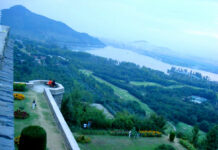most of the summer, Kashmir has been desperately praying for a rainfall. But it skipped even the peak of monsoon which many think is just another indicator towards Kashmir becoming a crucible for climatic change. It rained finally and rained cats and dogs. As incessant rains in the south Kashmir continued for a couple of days, the otherwise ‘thirsty’ Jhelum felt inundated for some time. The readings at Rambagh have already crossed 18 ft which necessitating a flood alert.
Floods are best managed not stopped. But the flood management has continued to be a grey area which gets least attention during the lean period. Kashmir’s erstwhile rulers lacked the exposure that their present day successors have but their wisdom in managing natural calamities goes unmatched. The flood channel that the erstwhile autocrats laid to help Srinagar protect itself during floods have remained the single largest contribution in managing floods that otherwise could devastate Srinagar. The new rulers opted for short cuts. Once the river is flowing by its brims, they have been traditionally blasting the embankment at a particular place that converts vast swathes into a flood basin.
For last many years, the civil society has been crying hoarse that de-silitation process of the flood channel be started. At one point of time, it was suggested that the silt from the channel would easily find use in the constructions sector especially at places where filling is mandatory. It could have gone into the making of the railways track that slices Kashmir into Upper Valley and Lower Valley. But somehow people behind the policy did not take the demand seriously.
While the officials must be terribly busy till the Jhelum reduces its discharge levels, the occasion should mark a beginning of thinking on long-term basis. Let us start dredging the flood channel properly and let it have some discharge throughout the year so that it prevents encroachers from nibbling the channel and helps the fish that are under severe stress because of the Uri hydel power project.
At the same time, there is a dire requirement of making calamity management a full time process. Technically, we have the schemes and the mechanism in place but all this becomes hyperactive once we embrace the crisis. Prior to the recent torrential rains, the area specific raining had massively impacted standing crops. In north and south, everywhere the peasantry is busy harvesting a crop that is severely damaged.
Nobody from the officialdom visited these places. To assess the damages is a far cry. Even if the system retains its priority of accepting the demands of the employees and not offering any help to the peasantry, supposedly the growth engine of the conflict-devastated economy, assessments would still help in prospective planning. Is anybody listening?









